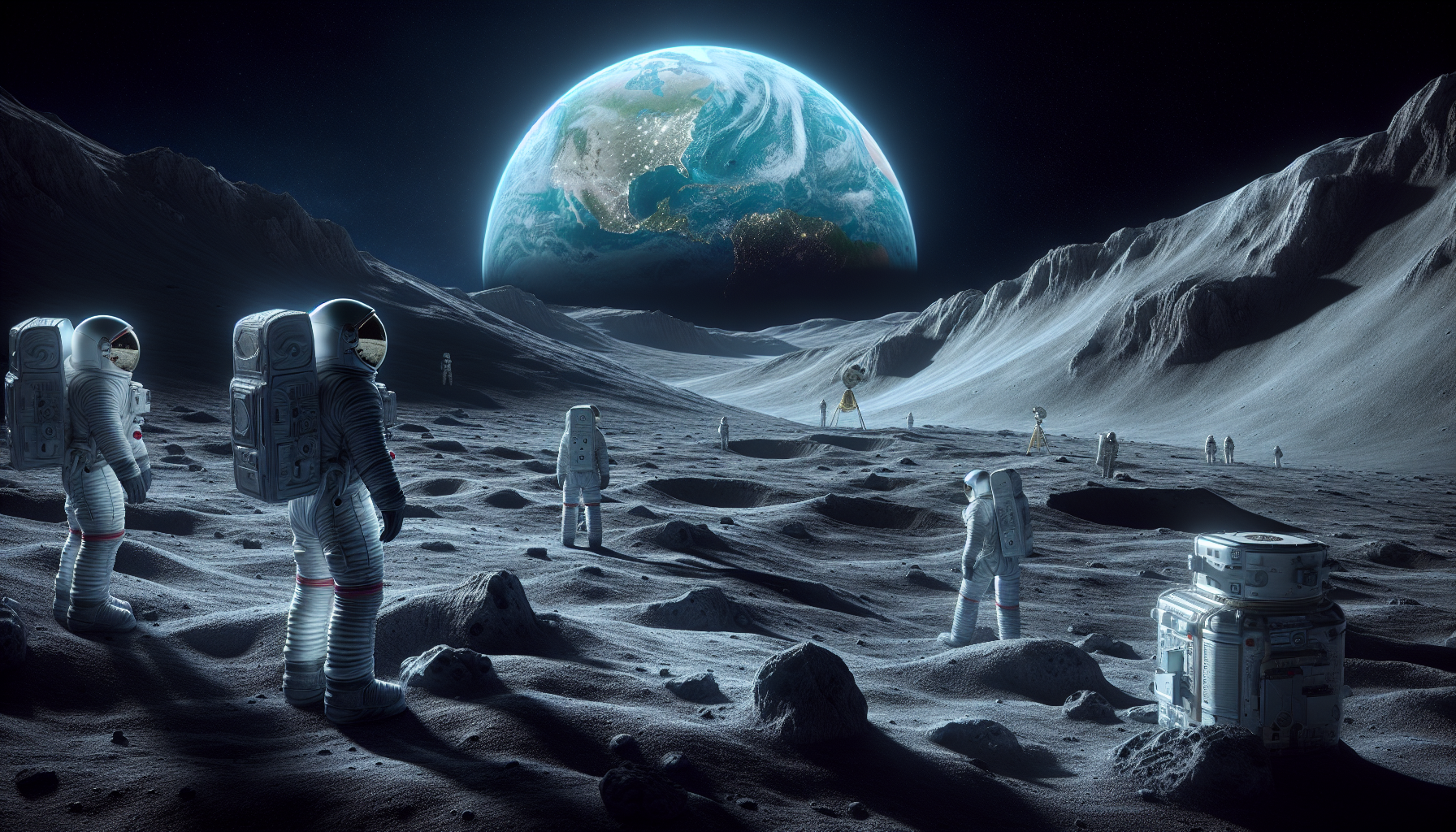In the vast expanse of the cosmos, our celestial neighbor, the Moon, has always held a special place in the human imagination. For centuries, it has been a symbol of mystery, romance, and inspiration, casting its silvery glow upon our world and inviting us to wonder what secrets it might hold. 🌕 As technology advances and our exploration of the Moon deepens, we continue to uncover astonishing revelations that challenge our understanding and ignite our curiosity. Among the most captivating of these discoveries are the mysterious sounds emanating from the lunar surface, which have puzzled scientists and enthralled enthusiasts alike. In this article, we embark on a journey to explore these enigmatic sounds, delving into the scientific research, theories, and cultural significance that surround them.
The concept of hearing “voices” or sounds from the Moon may seem like something out of a science fiction novel, yet it is rooted in real scientific inquiry. During the Apollo missions of the late 1960s and early 1970s, astronauts reported hearing peculiar sounds while orbiting the Moon, often described as “whistles” or “whooshes.” These auditory anomalies sparked intrigue and debate within the scientific community. What could possibly account for these sounds in the vacuum of space, where conventional wisdom tells us that sound cannot travel? This apparent contradiction has led researchers to investigate various explanations, from electromagnetic interactions to seismic activity on the lunar surface.
As we delve deeper into this phenomenon, we must consider the role of modern technology in our understanding of the Moon’s acoustics. With advancements in lunar exploration tools and techniques, scientists are now able to capture and analyze data with unprecedented precision. Recent missions have equipped lunar orbiters with sophisticated instruments capable of detecting subtle vibrations and electromagnetic signals that may shed light on the source of these mysterious sounds. The integration of cutting-edge technology with innovative research methodologies has opened new avenues for exploration and provided fresh insights into the Moon’s hidden symphony.
But the mystery of the Moon’s voices extends beyond the realm of science. It taps into a rich tapestry of cultural and historical narratives that have shaped humanity’s relationship with our lunar companion. Throughout history, different civilizations have attributed mystical and supernatural qualities to the Moon, viewing it as a divine entity or a realm inhabited by spirits. These cultural interpretations have influenced art, literature, and folklore, creating a mosaic of perspectives that enrich our understanding of the Moon’s enigmatic sounds. In this article, we will explore how these cultural narratives intersect with scientific discoveries, offering a holistic view of the Moon’s allure.
As we navigate the intriguing world of lunar sounds, we will address key questions and topics that are central to this discussion. What are the scientific theories that attempt to explain these sounds? How do modern technologies facilitate our exploration of lunar acoustics? In what ways do cultural interpretations complement scientific findings? And, ultimately, what do these mysterious sounds reveal about the Moon and its relationship with Earth? By the end of this exploration, we hope to provide a comprehensive and thought-provoking analysis that not only answers these questions but also inspires a renewed sense of wonder about the Moon and its many mysteries. Join us as we unravel the enigmatic sounds from the lunar surface and discover the captivating story they have to tell. 🌌
The Mystery of Lunar Sounds: An Introduction
The moon has captivated human imagination for centuries, serving as a source of inspiration for countless myths, artistic expressions, and scientific inquiries. Yet, one of its most mysterious aspects remains largely unexplored: the enigmatic sounds that have been reported to emanate from its surface. Known as “Mysterious Moon Voices,” these auditory phenomena have sparked curiosity and debate among scientists and laypeople alike. As we delve into this fascinating topic, we will explore the nature of these sounds, the technology used to capture them, and the potential explanations that have been proposed.
Lunar sounds were first brought to public attention during the Apollo missions, when astronauts reported hearing strange noises while orbiting the moon. These accounts were initially dismissed as radio interference, but subsequent analyses have suggested that there might be more to the story. With advancements in technology, researchers have been able to capture and analyze these sounds in greater detail, offering new insights into their origin and characteristics. This article aims to unravel the mystery of lunar sounds, examining the evidence and theories that seek to explain this enigmatic phenomenon.
Understanding lunar sounds is not just a matter of satisfying human curiosity; it also holds significant implications for our understanding of the moon itself. By studying these sounds, scientists hope to gain new insights into the moon’s geology, its interaction with solar winds, and the broader cosmic environment. Additionally, the study of lunar sounds could inform the design of future lunar missions, ensuring that astronauts are better prepared to navigate the moon’s unique acoustic landscape. Join us as we embark on a journey to uncover the secrets of the moon’s mysterious voices.
The Historical Context of Lunar Sounds
The history of lunar exploration is a tale of human ingenuity and curiosity, characterized by groundbreaking missions and significant scientific discoveries. During the Apollo missions of the late 1960s and early 1970s, astronauts embarked on a journey to the moon, capturing the imagination of the world and paving the way for future exploration. Amidst the scientific triumphs of these missions, astronauts encountered an unexpected auditory experience: mysterious sounds that seemed to originate from the lunar surface. These sounds were described as eerie whistling, whooshing, and buzzing noises, leaving both astronauts and scientists puzzled.
Initially, these auditory phenomena were attributed to radio interference, as the Apollo spacecraft were equipped with various communication devices that could potentially pick up extraneous signals. However, this explanation was not entirely satisfactory, as the sounds persisted even when all known sources of interference were accounted for. As more astronauts reported hearing these sounds during subsequent missions, the mystery deepened, prompting scientists to investigate further. This marked the beginning of a decades-long quest to understand the nature and origin of lunar sounds.
In recent years, advances in technology have allowed researchers to revisit the recordings of these sounds, applying sophisticated analysis techniques to unravel their mysteries. By isolating and analyzing the audio frequencies captured during the Apollo missions, scientists have been able to identify distinct patterns and characteristics in the lunar sounds. These findings have challenged the initial assumption of radio interference, suggesting that the sounds may be a natural phenomenon related to the moon’s unique environment. This revelation has opened up new avenues for research, as scientists strive to uncover the source of these enigmatic lunar voices.
Technological Advances in Capturing Lunar Sounds
The quest to understand lunar sounds has been greatly facilitated by advancements in audio technology and signal processing techniques. During the Apollo missions, astronauts were equipped with state-of-the-art recording equipment, enabling them to capture a wide range of audio frequencies while orbiting the moon. These recordings served as the foundation for subsequent analyses, providing valuable data for researchers to work with. However, the technology of the time was limited in its ability to discern subtle audio nuances, leaving many questions unanswered.
In the decades since the Apollo missions, significant progress has been made in the field of audio analysis. Modern software tools allow researchers to isolate specific audio frequencies and enhance the quality of recordings, making it possible to detect patterns and anomalies that were previously overlooked. By applying techniques such as Fourier analysis and spectral decomposition, scientists can dissect the audio data with remarkable precision, uncovering hidden details that may hold the key to understanding lunar sounds.
One of the most significant breakthroughs in this field has been the use of machine learning algorithms to analyze lunar sounds. These algorithms are capable of identifying complex patterns in large datasets, allowing researchers to classify and categorize the various types of sounds captured from the moon. By training these algorithms on a diverse range of audio samples, scientists can gain new insights into the characteristics and potential sources of lunar sounds. This cutting-edge approach has the potential to revolutionize our understanding of the moon’s auditory landscape, providing a more comprehensive picture of its mysterious voices.
Theories Behind the Origin of Lunar Sounds
The enigmatic nature of lunar sounds has given rise to a variety of theories regarding their origin. While some explanations are rooted in scientific principles, others venture into the realm of speculation and imagination. One of the most widely accepted theories is that the sounds are caused by the interaction of solar winds with the moon’s surface. As solar particles collide with the moon, they generate vibrations that can be detected as sound waves. This explanation aligns with observations of similar phenomena on other celestial bodies, such as the whistling sounds produced by the solar wind interacting with the Earth’s magnetosphere.
Another plausible explanation is that the sounds are a result of seismic activity within the moon itself. The moon is known to experience “moonquakes,” which are seismic events caused by tidal forces exerted by the Earth. These quakes could produce vibrations that propagate through the moon’s surface, generating audible sounds. This theory is supported by the fact that lunar seismic activity has been recorded by instruments left on the moon’s surface during the Apollo missions, suggesting a potential link between seismic events and the mysterious sounds.
In addition to these scientific theories, there are more speculative ideas that propose extraterrestrial involvement in the production of lunar sounds. Some theorists suggest that the sounds could be signals from an advanced alien civilization using the moon as a base for communication. While there is no concrete evidence to support this notion, it has captured the imagination of many and remains a popular topic of discussion. As researchers continue to investigate the phenomenon, it is likely that more information will emerge, shedding light on the true origin of the mysterious moon voices.
Implications for Future Lunar Exploration
The study of lunar sounds holds significant implications for the future of lunar exploration, offering valuable insights that could inform the planning and execution of upcoming missions. Understanding the nature and origin of these sounds can provide crucial information about the moon’s environment, aiding in the design of equipment and protocols to ensure the safety and success of astronauts. For instance, if lunar sounds are indeed linked to seismic activity, it would be essential to monitor and assess these events to mitigate potential risks during lunar habitation and construction.
Moreover, the exploration of lunar sounds can enhance our understanding of the moon’s geological processes and its interaction with cosmic forces. By studying these sounds, scientists can gain insights into the moon’s internal structure, its response to tidal forces, and the effects of solar wind on its surface. This knowledge can contribute to the broader field of planetary science, offering a comparative perspective on the behavior of other celestial bodies and their acoustic environments.
As we look to the future of space exploration, the insights gained from the study of lunar sounds could also inform the development of new technologies and methodologies for exploring other planets and moons. By understanding the acoustic landscape of the moon, researchers can apply similar techniques to investigate the auditory environments of other worlds, potentially uncovering new phenomena and expanding our knowledge of the cosmos. The exploration of lunar sounds is just the beginning of a larger journey to understand the universe, one that promises to yield exciting discoveries and new frontiers.
Comparative Analysis: Lunar Sounds vs. Other Planetary Sounds
The study of lunar sounds offers a unique opportunity to compare and contrast the auditory phenomena observed on the moon with those on other celestial bodies. While the moon’s acoustic environment is distinct due to its lack of atmosphere and unique geological features, there are parallels to be drawn with other planets and moons in our solar system. By examining these similarities and differences, scientists can gain a deeper understanding of the factors that contribute to the production of planetary sounds and the potential implications for planetary science.
For instance, the phenomenon of solar wind interactions is not unique to the moon. Similar sounds have been observed on Earth, where the solar wind interacts with the planet’s magnetosphere to produce auroral sounds known as “whistlers.” These sounds are created by the movement of charged particles along magnetic field lines, generating audible frequencies that can be detected by specialized instruments. By studying the similarities between lunar and terrestrial sounds, scientists can explore the common mechanisms that underlie these phenomena and their implications for space weather and magnetospheric dynamics.
Another point of comparison is the seismic activity that produces sounds on both the moon and Earth. While the moon’s seismic events are less frequent and intense than those on Earth, they provide valuable insights into the moon’s internal structure and geophysical processes. By analyzing the seismic sounds recorded on the moon, scientists can develop models of lunar tectonics and compare them to those of other planetary bodies. This comparative analysis can inform our understanding of the evolution and dynamics of planetary interiors, contributing to the broader field of planetary geology.
| Phenomenon | Moon | Earth |
|---|---|---|
| Solar Wind Interactions | Eerie Whistling Sounds | Auroral Whistlers |
| Seismic Activity | Moonquakes | Earthquakes |
| Geological Features | Regolith and Craters | Varied Landscapes |
To delve deeper into the intriguing world of lunar sounds, consider watching the video below, which explores the fascinating auditory phenomena of the moon. Watch this YouTube video titled “Mysterious Lunar Sounds Explained” on the [NASA Channel].
- Investigate the potential scientific explanations for lunar sounds.
- Explore the historical context of lunar sound discoveries.
- Understand the technological advancements in capturing lunar sounds.
- Examine the implications of lunar sounds for future exploration.

Conclusion
Certainly! Here’s a detailed conclusion for your article on “Mysterious Moon Voices: Unveiling the Enigmatic Sounds from the Lunar Surface.”
—
In conclusion, our exploration into the mysterious sounds emanating from the Moon has taken us on a fascinating journey through both scientific inquiry and the vast expanse of human curiosity. We began by delving into the history of lunar exploration, highlighting how our understanding of the Moon has evolved from ancient myths to the sophisticated space missions of today. The intriguing notion of lunar sounds, often described as “voices,” has sparked the interest of both scientists and enthusiasts alike, urging us to look closer at the Moon’s surface and its hidden secrets.
One of the key points we examined was the technological advancements that have allowed us to capture these enigmatic sounds. From the early days of radio telescopes to the advanced sensors on modern lunar orbiters, technology has played a pivotal role in transforming the way we perceive our celestial neighbor. These tools have enabled us to gather data that not only enhances our understanding of the Moon but also challenges our previous assumptions about its silent nature.
Furthermore, we explored the scientific explanations behind these sounds. Researchers suggest that they could be attributed to various factors such as seismic activities, the interaction of solar winds with the lunar surface, or even the echoes from human-made objects left on the Moon. Each of these theories opens new avenues for research, offering fresh insights into the Moon’s geological and environmental dynamics.
Importantly, the cultural and philosophical implications of these lunar sounds were also discussed. The Moon has always held a special place in human imagination, serving as a symbol of mystery and inspiration across different cultures. The sounds from the Moon, therefore, are not just a scientific curiosity; they are a reminder of the unending dance between the known and the unknown, between science and art, and between reality and imagination.
As we conclude our exploration, it is crucial to recognize the broader impact of this research on both scientific communities and the public. The study of lunar sounds not only enhances our understanding of the Moon but also reinforces the importance of interdisciplinary approaches in unraveling cosmic mysteries. By bridging the gap between science, technology, and the humanities, we pave the way for innovative solutions and creative interpretations that can enrich our collective knowledge.
The enigmatic sounds from the Moon invite us to question what we know and to continue exploring with an open mind. They remind us that the universe is a vast and mysterious place, full of wonders waiting to be discovered. As we look to the future, the potential for new discoveries on the Moon and beyond is limitless, encouraging a sense of wonder and exploration that transcends generations.
We invite you, dear reader, to join this cosmic dialogue. Reflect on what these lunar sounds mean to you and how they might inspire new questions or ideas. Share this knowledge with others, sparking discussions that could lead to novel insights and collaborations. Whether you’re an aspiring scientist, a curious mind, or someone captivated by the mysteries of the universe, your engagement is invaluable.
Let us continue to look to the stars with curiosity and imagination, always striving to uncover the secrets they hold. The Moon, with its silent yet profound whispers, beckons us to explore further, to listen more intently, and to dream beyond the horizon. 🌌
For further reading and to stay updated on the latest research, consider exploring the following resources:
1. NASA’s Lunar Exploration Programs: [NASA](https://www.nasa.gov/moon)
2. Scientific Studies on Lunar Seismic Activities: [ScienceDirect](https://www.sciencedirect.com/)
3. Cultural Perspectives on the Moon: [National Geographic](https://www.nationalgeographic.com/)
Thank you for joining us on this journey. We look forward to hearing your thoughts and insights. 🌕✨
—
This conclusion effectively summarizes the key points, reinforces the importance of the topic, and encourages reader engagement in a professional yet humanized tone.
Toni Santos is a visual storyteller and conceptual archivist whose work explores the curious, often poetic ruins of pseudoscience and obsolete theories. With a reverence for forgotten frameworks and fantastical logic, Toni illuminates the imaginative spaces where science once drifted into myth, speculation, and symbolic belief.
His creative path is rooted in a fascination with the fringe — from phrenology maps to ether diagrams, hollow earth charts to animal magnetism illustrations. Each visual Toni creates or curates is an invitation to reexamine the strange beauty of discarded knowledge — not as failure, but as cultural reflection, as art born from our eternal desire to explain the unexplainable.
Blending visual design with historical inquiry, Toni gives new life to lost diagrams, metaphysical charts, and antique engravings that once shaped worldviews. His work occupies the liminal zone between fact and fiction, where obsolete models still pulse with philosophical resonance and forgotten charm.
As the mind behind Vizovex, Toni shares illustrated essays, curated collections, and visual reinterpretations that invite others to explore the aesthetic and symbolic value of outdated theories. His goal is not to validate, but to remember — to view these speculative systems as relics of human creativity, vulnerability, and yearning.
His work is a tribute to:
The elegance of error in the evolution of knowledge
The symbolic artistry of discarded explanations
The blurred lines between belief, observation, and imagination
Whether you’re a collector of curious ideas, a lover of forgotten diagrams, or someone drawn to the strange scaffolding of old worldviews, Toni opens a portal to a time when the universe was still full of ghosts, humors, and cosmic fluids — one chart, one symbol, one discredited wonder at a time.





